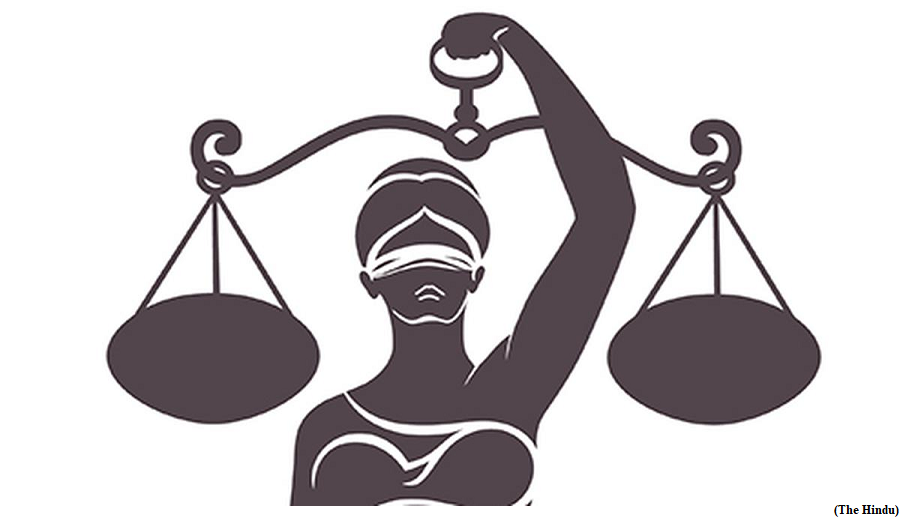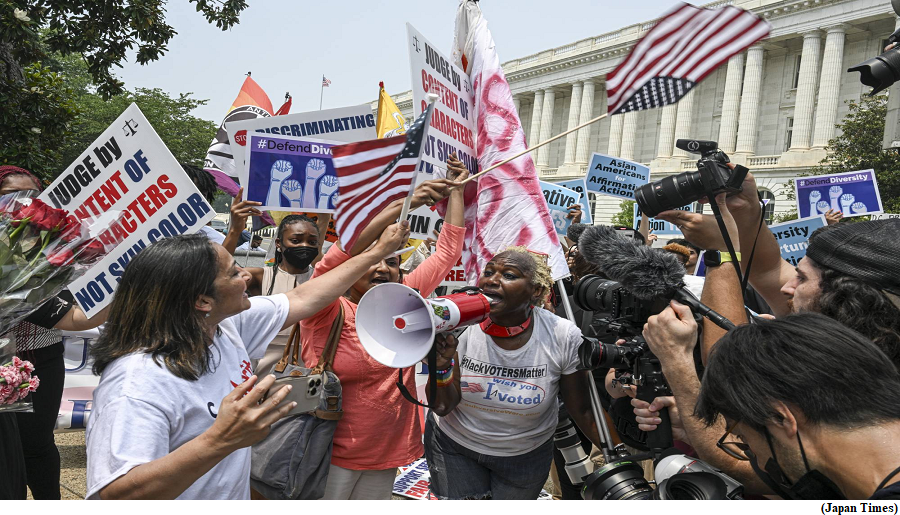Coming, women-only courts for alternative dispute resolution (GS Paper 2, Governance)

Why in news?
- The Union government is set to launch an initiative under which women-only courts will be set up at the village-level as an alternative dispute resolution forum for issues such as domestic violence and property rights, and to counter the patriarchal system.
- The scheme will be launched on a pilot basis in 50 villages each in Assam and Jammu and Kashmir in August and extended to the rest of the country over the next six months.
Composition:
- The Nari Adalat (women’s court) of each village will have seven to nine members – half of which would be the elected members of the gram panchayat while the other half will include teachers, doctors and social workers, who would be nominated by the villagers.
- Members known as Nyaya Sakhis (legal friends) will be nominated or selected by the gram panchayat, while the head of Nari Adalat called the Mukhya Nyaya Sakhi (chief legal friend) will be chosen among the Nyaya Sakhis.
- The tenure of the head will be generally six months after which a new one will be selected.
Role:
- This platform will leverage their potential as advisers and leaders within their communities, functioning as a pressure group.
- The court will not only address individual cases of women and girls within the local community who require assistance or have grievances, but also raise awareness of government schemes and the legal rights and entitlements of women. The Nari Adalat will, however, not hold any legal status.
- The services provided will include alternative dispute resolution and grievance redressal, counselling, evidence-based decision making, pressure group tactics, negotiation, mediation and reconciliation with mutual consent for accessible and affordable justice.
- Additionally, the platform will engage with citizens, promoting awareness about women’s rights, legal opinions, various schemes and collecting public feedback.
Implementation:
- The scheme would be run by the Ministry of Women and Child Development under the Sambal sub-scheme of Mission Shakti, which is dedicated to strengthening women’s safety, security and empowerment.
- The implementation process will be done in collaboration with the Ministry of Panchayati Raj, the Ministry of Rural Development and Common Service Centres operated by the Ministry of Electronics and Information technology.
The U.S. SC ban on race-based admissions
(GS Paper 2, International Relation)
Why in news?
- The U.S. Supreme Court recently struck down race-conscious student admissions at the University of North Carolina (UNC) and Harvard College, calling such affirmative action policies unlawful.
- The justices voted 6-3 and 6-2 in favour of Students for Fair Admissions, an organisation against race-based admissions in colleges.
- The case argued whether admissions systems used by Harvard College and UNC are lawful under the Equal Protection Clause of the Fourteenth Amendment.

What is affirmative action?
- Affirmative action is a policy that aims to ensure equal opportunities for historically underrepresented demographics or minorities in educational or professional sectors.
- In 1961, President John F. Kennedy became the first leader to link the term with racial equality. He signed an executive order, instructing the government contractors to take “affirmative action to ensure that applicants are employed, and that employees are treated during employment, without regard to their race, creed, colour, or national origin”.
- In 1969, President Richard Nixon signed yet another executive order, directing the U.S. government “to provide equal opportunity in federal employment for all persons, to prohibit discrimination in employment because of race, colour, religion, sex, national origin, handicap, or age, and to promote the full realisation of equal employment opportunity through a continuing affirmative program in each executive department and agency”.
- A landmark ruling in the matter came in 1978, in the Regents of the University of California versus Bakke case when the Supreme Court ruled that schools could not use affirmative action to rectify historical racial discrimination, but that they could weigh race as one of the many factors in admissions.
What does the judgment say?
- The recent judgment of the U.S. Supreme Court says that admission programmes of both Harvard College as well as the UNC lack measurable objectives that would validate the use of race as a criterion.
- It also added that both these admission programmes “unavoidably” use race in a negative manner, and hence do not serve the guarantees of the Equal Protection Clause of the Fourteenth Amendment of the U.S. Constitution.
What is the Equal Protection Clause?
- The Fourteenth Amendment of the U.S. Constitution addresses citizenship issues and the rights of citizens.
- The Equal Protection Clause, under the Fourteenth Amendment, requires the government to accord equality to all citizens and avoid denial of protection enjoyed by other people or demographics. The Equal Protection clause is considered crucial to the protection of citizens’ civil rights.
Was race a factor for college admissions?
- According to Harvard, around 40% of U.S. colleges and universities consider race in some fashion. The current judgment states that admissions applications at Harvard College are assigned a numerical score in six categories; academic, extracurricular, athletic, school support, personal and overall, during its initial screening.
- “Overall” is composite of five other ratings and can include the applicant’s race as a factor. UNC also has a similar process, the admissions office assigns a numerical rating to the applicant based on several categories, and race is considered a factor in the review.
What will be the impact of the decision?
- This is not the first time that affirmative action has been declared unlawful for U.S. colleges. The State of California, for example, banned affirmative action in 1996 in public universities.
- Acting as amicus curiae in the recent case, the President and Chancellors of the University of California (UC) informed the Supreme Court that despite their extensive efforts, they have struggled to enrol a racially diverse student body into its programmes.
- The amicus curiae also said that since 1996, “freshmen enrollees from underrepresented minority groups dropped precipitously at UC, and dropped by 50% or more at UC’s most selective campuses”.
Why are India-Russia trade payments in crisis?
(GS Paper 3, Economy)
Why in news?
- As India continues to import oil from Russia, it is getting tougher for the country to pay for it. On the one hand, it faces repercussions of breaching the oil price cap of $60 a barrel put in place by the U.S. and European nations as Russia offers lower discounts on its crude.
- On the other hand, using currencies like the Chinese yuan for payments, which India has already started doing, has its own geopolitical ramifications amid strained ties with China.

Where do oil imports from Russia stand?
- In February 2023, Russia surpassed Saudi Arabia to become the second biggest exporter of crude oil to India in FY23.
- Since the start of Russian President Vladimir Putin’s “special military operation” in Ukraine on February 24, 2022, Russia has been hit by Western banking and economic sanctions.
- Against this backdrop, it found a ready market for its goods, especially crude oil, in India and offered steep discounts. India, meanwhile, unlike the West, chose to not join the list of countries formally imposing sanctions on Russia.
- As a result, India’s imports of crude oil from Russia increased nearly 13 times in 2022-23 to over $31 billion from less than $2.5 billion in 2021-22. Russia is now the largest supplier of oil to India, displacing traditional players such as Iraq, Saudi Arabia, and UAE.
- In the four-month period between November 2022 and February 2023, Russia took over the top spot from Iraq. India accounted for more than 70% of the seaborne supplies of Russian-grade oil under $60 dollars a barrel in May.
Which currency is being used for payments?
- As part of war-induced sanctions on Russia, the U.S., the EU, and the U.K. have blocked multiple Russian banks from accessing the Society for Worldwide Interbank Financial Telecommunication (SWIFT), a global secure interbank system. An estimated $500 million is pending for goods already shipped by Indian exporters to Russia and it is now not possible to get the payments through the SWIFT channel.
- Besides an oil ban jointly agreed between multiple countries last year, it was also decided to cap the price to a maximum of $60 per barrel of Russian oil transported through waterways.
- While India is not a formal signatory, it has tacitly agreed to maintain the price cap as much as possible. Besides, banks and traders may not want to get involved in transactions that breach the oil cap over fears of repercussions for their funds.
- Until recently, the blends of oil India was importing from Russia were largely below the price cap fixed by G-7 countries and India was able to pay for the oil using dollars. However, Russia has lowered its discounts due to high demand from China and lower grade oil is now in short supply.
What about the rupee-rouble mechanism?
- India was in negotiations with Russia to reactivate the rupee-rouble trade arrangement, which is an alternative payment mechanism to settle dues in rupees instead of dollars or euros.
- However, the rupee-rouble payment mechanism could not take off. On the flip side, Russia has also pointed out that it finds the rupee to be “volatile”.
- The unforeseen surge in oil trade between India and Russia in one year alone has led to a massively ballooning trade deficit.
- India’s trade deficit with Russia touched $43 billion in 2022-23 as it imported goods worth $49.35 billion while its exports were at $3.14 billion. This has led to staggering amounts of Indian rupees in Russian banks that cannot be used by Russia in its war efforts.
Is de-dollarisation being attempted?
- Since the dollar is largely considered the global reserve currency, many countries have seen the U.S. sanctions as a way for America to weaponise the dollar. This has given rise to countries looking at de-dollarisation, which means the replacement of the U.S. dollar with other currencies as the global reserve currency.
- India too, has recently released a roadmap for the internationalisation of the Indian rupee to create broader acceptance.
- The value and the acceptability of any currency depend mainly on its purchasing power, that is, the number of goods and services that can be bought using it and right now, the daily average share for the rupee in the global foreign exchange market is ~1.6%, while India’s share of global goods trade is ~2%.
- Indian refiners have also settled some non-dollar payments for Russian oil in the Chinese yuan and the UAE dirham.
What next?
- Experts have pointed out that while India could use the yuan for payments, there are concerns about how that would appear geopolitically as it continues to have strained ties with Beijing since the border standoff.
- Besides, another solution could be to counter the deficit with Russia by getting it to make investments in energy projects in India or to invest in government bonds.




